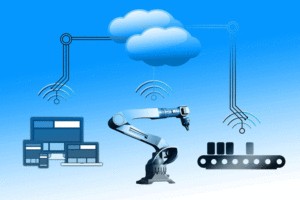Today’s cutting-edge machine vision systems rely on smaller and faster Industrial Internet of Things (IoT) devices to collect massive amounts of digital data and report it to powerful cloud-based computers. Artificial intelligence (AI) systems process this data and make decisions based on this input. Recent technological developments in AI have significantly improved processes such as optical character reading, surface and texture inspection and complex 3D measurements.
 In addition, deep learning (DL) technology picks up trends and abnormalities in the data, allowing the systems to automatically fine tune themselves. This allows a machine to adapt to subtle variations inherent in manufacturing and other sophisticated environments. Due to these dramatic recent developments, machine vision is rapidly moving out of the factory and into new territories such as indoor farms, distribution warehouses and retail establishments.
In addition, deep learning (DL) technology picks up trends and abnormalities in the data, allowing the systems to automatically fine tune themselves. This allows a machine to adapt to subtle variations inherent in manufacturing and other sophisticated environments. Due to these dramatic recent developments, machine vision is rapidly moving out of the factory and into new territories such as indoor farms, distribution warehouses and retail establishments.
Common Machine Vision Operations
These Industry 4.0 capabilities have significantly improved the performance of machine vision systems and increased their reliability and operational efficiencies. However, machine vision is still much better at some tasks than others. Four common operations, that are especially well suited for machine vision, are the guidance of robots, metrology, surface inspection, and the reading of identification codes.
Robot Guidance
In vision-guided robotics, machine vision is used to identify an object and determine its location so that a robotic arm can grasp, move, or process it. Machine vision systems can also efficiently guide mobile autonomous robots to their destinations. They avoid obstructions and utilize optimized paths based on input from AI enabled computer networks.
Metrology
Metrology is a very precise measurement of physical dimensions. Machine vision is quickly growing in this field due to the huge surge in the ability to collect and affordably process the large amounts of data collected by the surface scanner. Rule-based AI is well suited to this particular process because dimensional tolerancing is well-defined and consistent.
Surface Inspection
Surface inspection is another area of growth that utilizes machine vision to detect defects in the color or texture of a surface. It compares the image being evaluated with an ideal standard specimen. Because the process is subjective and less mathematically precise, a deep learning neural net AI is generally utilized.
Identification Code Reading
Identification is another process used in both manufacturing and logistics operations. Machine vision is very good at quickly reading 1D or 2D bar codes. Text can also be reliably read at high speeds using optical character recognition. So, a mix of rule-based and deep learning neural nets can be utilized depending on the specific identification requirements.
Is your industry ready for machine vision systems? Contact Keller Technology to learn more about the latest innovations in machine vison and the new ways that these systems can be successfully deployed in today’s modern factory.
